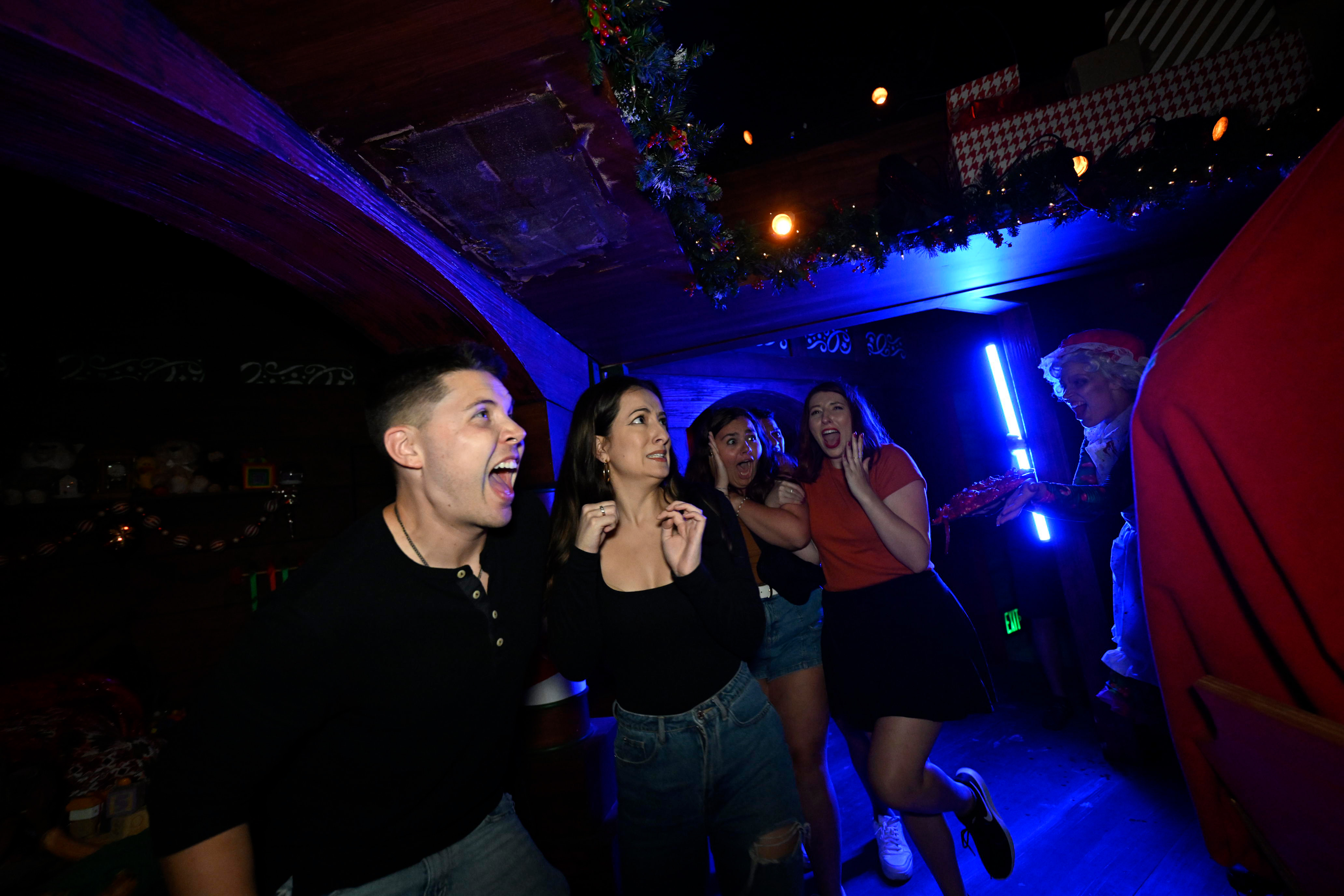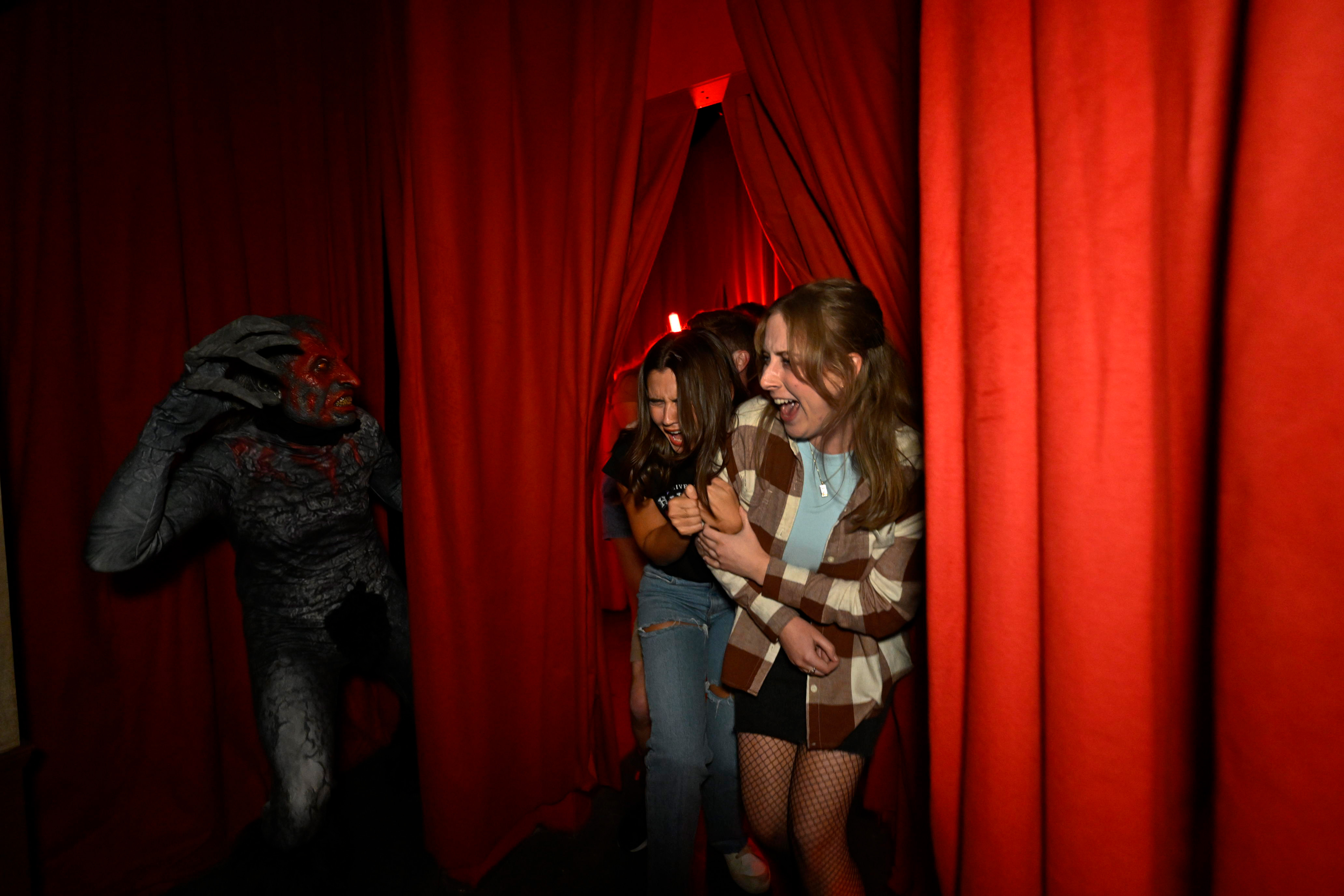
What does “horror” sound like to you? Is it a creepy synth? Pummeling guitars? A maddening drone?
Every year, the creative team behind Universal Studios’ Halloween Horror Nights, the most fun, spooky (and Sydney Sweeney-approved!) experience in the country, is tasked with creating music to frighten over one million guests. And after visiting the 10 haunted houses created for the the 2024 edition in Orlando, including intense walk-through experiences themed around A Quiet Place, Ghostbusters, and Insidious, let me tell you: they succeeded.
We recently spoke to assistant director Lora Sauls, senior show director Charles Grey, and composer Sara Barone (who wrote the score for the “Universal Monsters: Eternal Bloodlines” house) about finding horror music inspiration for HHN, theremins, and the most overplayed Halloween song.
***
How does the music get picked for the haunted houses?
Lora Sauls: I think the show direction team does a beautiful job of telling the story through sound effects, the audioscape, the score that they play in the haunted houses. Every year, we come up with original content houses that have new stories. And then we get to work with some of the biggest horror franchises, which is really cool. When we’re working with the franchises, we lean into the score that accompanies those films and franchises to make sure that we’re telling their stories. When it comes to original content, our show direction team thinks outside the box on how to tell that story with the score.
Charles Grey: Music in the house, a lot of times, is a character. You just have to determine how much of a character. Is it the main character? Is it a supporting character? I’m just going to make this up, but sometimes if you have a pulse-pounding score, it can detract or it can add. It depends on the story you’re trying to tell. So, for example, this year in “Triplets of Terror,” my goal was to have you feel depressed when you exited the house. So everything was very long strings and minor chords… It’s like this rainy, dreary feeling. And then, in the Major Sweets house, we selected songs from 1951 to 1953, a very specific time era, and it’s all this very bubblegum pop, kind of happy amongst all the horrific torture. But yeah, it’s really determining how far in front you want the score to be. For instance, in “A Quiet Place,” you would think there’s no score in there, but I consider the drones that we selected to be the score. It’s low enough that you’re feeling it, but you’re not truly hearing it.
What is the length of the music loops in the houses?
Sara Barone: For me, the process was I came up with musical ideas and themes in more of a linear form, not thinking so detailed about timings. But then when once the score became fleshed out, some of the loops were quite short. Some were 30 seconds, some were nine seconds, some were 13 seconds. It depended on the function of the loop. So it was very important to come up with thematic ideas that weren’t overly long and complex. And so one of the first things I did was come up with a theme for Saskia [Van Helsing] and it was just a few notes and I repurposed it in different ways, using different orchestrations and instrumentation. But, yeah, it’s just a few notes, and you hear it very quickly. It’s used in various contexts throughout the whole score.

What can you tell us about the inspiration for the “Universal Monsters: Eternal Bloodlines” house?
Sara: I’m such a fan of the [Universal horror] franchises, and I was very familiar with them. One of my favorite scores of all time is Jerry Goldsmith’s score for The Mummy, so I was really excited that there was an Egypt section of this house. That score has been so inspiring to me for years. For this score, I hoped to pay tribute to the classic monster score vibe with the orchestral arrangement, but in a modern context, because I also incorporated some synthesizers and a lot of vocal textures, specifically female vocals. It’s an all-female monster house, so I thought that would be a cool sound to play with. There’s a lot of solo female vocals, some choir and lots of extended techniques and different unusual vocal sounds that I warped electronically as well.
There’s this “classic” idea of what haunted house music sounds like. It’s what you might hear in a Scooby-Doo cartoon. How much do you lean into that? Or are you trying to shy away from it?
Sara: You know, for me, I think that there are ways to achieve a similar effect [as] some of those traditional styles. It’s very common in the classic horror monster scores to have aleatoric orchestral effects, very non-traditional ways of playing instruments. And so for me, with this score, I incorporated some of that, but I also played with electronically manipulating some of those sounds. So I’ll have an orchestral string effect that sounds a certain way, and in its original form, it’s reminiscent of those classic monster scores. But then I’ll manipulate it by throwing it through a guitar pedal, or some sort of effect that makes it feel a little bit different. Maybe a little bit more modern, but it still is very scary and achieves a similar effect that the original sound did.

Are theremins cool?
CG: I do want to comment on that. Because our houses are so diverse, there’s 10 different stories that we’re telling. We rarely actually get to dabble in that classic, “cheesy” haunted house sound. And so I try to put a theremin somewhere every year. I sneak it in, and then I usually get called out on it. I even told my wife two years ago, she goes, “What do you want for your birthday?” I said, “A theremin.” And she’s like, “I am not having that played in our house all the time,” but theremins are awesome. I’m just defending them.
Is there a currently unrepresented genre of music that you would like to hear in a future house?
CG: Lora, if you remember, maybe two or three years ago, we had the Scarecrow Zone in Central Park, and in that one, it was a lot of lonely guitar and slight banjo with some pitch bending and stuff. I would love to see that kind of mountain music sound a little more sinister, kind of like a gothic Southern sound. It’s not tapped into as much as I think we could. And so I think that’d be a fun challenge for us to go that way.
Sara: I recently got a banjo and started playing with bowing it. It’s the craziest sound. It sort of sounds like a banjo, but not any banjo you’ve ever heard before. So that just got me thinking about that. That would be super cool.
How do you pick the music for the scare zones, where people are walking around the park but not in an actual house?
LS: We try to have our overall sound. We try to have different show directors do that in different years, so that we get different takes on what that overall sound should be. But I loved when Charles did the overall music a couple years ago. He was like, “I want to hear a song that makes me feel like I’m in the event, but I can just sit there and listen to it. I can go grab a hot dog, I can go grab a soda, I can grab a cold beer if I wanted to, and I would still like to hear the sound.” We do have an overall BGM [background music] that’s throughout the whole park, and then we have specific audio designs for our scare zones. So in between those scare zones is where you’ll hear that overall.

Have you heard from any famous singers about their love for Halloween Horror Nights?
LS: Ariana Grande is a huge fan of our event. She comes to the event quite often, and we’ve heard nothing but amazing things that she absolutely loves.
And finally, what is the most overplayed Halloween song? And what is your favorite Halloween song?
CG: I think we hear “Monster Mash” way too much during Halloween time. Great song, but I only need to hear it once. My daughter’s learning violin right now, and she’s never seen the film Halloween, but she randomly started playing it [mimics John Carpenter score]. I didn’t even know. And I was like, What is this? It actually scared me. John Carpenter’s music, and if you haven’t had a chance to hear some of his later stuff, is really cool and just simple and good. His electronic stuff’s really cool. So I just like John Carpenter’s music a lot for Halloween.
Sara: I think that that piano theme from John Carpenter is probably the most overplayed. I do love it, but that was the thing I thought of immediately for me. One of my favorite Halloween scores is Hocus Pocus. I love that score, and it just brings back memories to my childhood.
LS: For me, “Thriller” is not Halloween music. It came out not during Halloween, but I think it’s played a little too much during Halloween. And then I would agree I love John Carpenter’s music. We don’t hear it enough. But I also agree with Sara. I’m a huge Hocus Pocus fan as well.
Halloween Horror Nights runs on select nights until November 3. You can find more information here.
